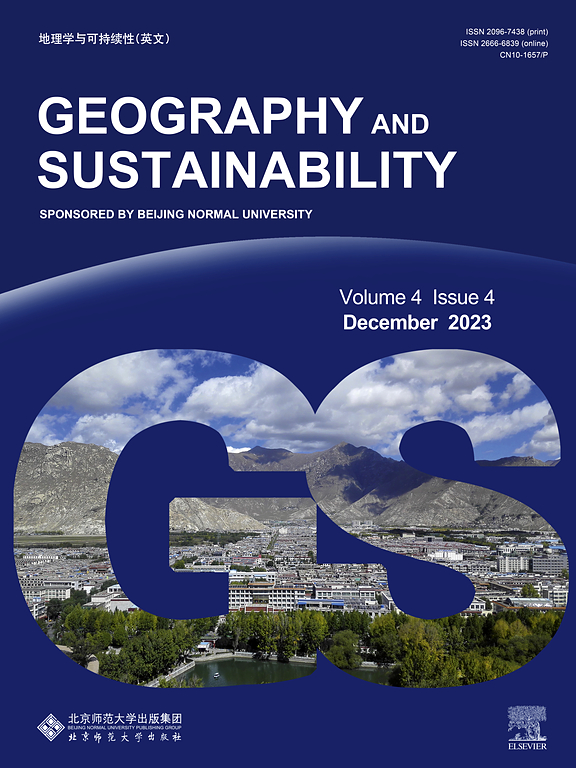综合地理学研究框架:复合驱动-系统演化-耦合机制-协同调节
IF 8
1区 环境科学与生态学
Q1 GEOGRAPHY, PHYSICAL
引用次数: 0
摘要
在持续的全球环境变化和对可持续发展的迫切追求中,人类-环境系统呈现出日益复杂的动态演变和空间关系,迫切需要创新的研究框架。综合地理学综合了自然地理学、人文地理学和地理信息科学,为理解复杂的人-环境系统提供了关键框架。本文基于气候变化、生物多样性丧失、资源稀缺、社会生态相互作用等近年来人类环境系统的重要文献和联合国评估报告所强调的关键问题,提出了一个新兴的综合地理学研究框架——“复合驱动-系统进化-耦合机制-协同调节(CSCS)”。该框架从多种复合驱动力出发,延伸到这些驱动力所引发的人-环境系统结构、过程和功能的演变,探索人-环境系统内部的耦合,并呼吁在协同作用中进行旨在可持续发展的监管。主要的研究前沿包括理解冲击的级联“进化耦合”效应;测量系统弹性、阈值和安全、公正的操作空间边界;明确跨尺度联动机制;实现多目标可持续性的协同效应。这一框架将有助于促进综合地理学的跨学科整合和发展,为全球可持续发展议程提供地理解决方案。本文章由计算机程序翻译,如有差异,请以英文原文为准。

Research framework for integrated geography: Composite driving–system evolution–coupling mechanism–synergistic regulation
Amid ongoing global environmental change and the critical pursuit of sustainable development, human–environment systems are exhibiting increasingly complex dynamic evolutions and spatial relationships, underscoring an urgent need for innovative research frameworks. Integrated geography synthesizes physical geography, human geography, and geographic information science, providing key frameworks for understanding complex human–environment systems. This editorial proposes an emerging research framework for integrated geography—“Composite driving–System evolution–Coupling mechanism–Synergistic regulation (CSCS)”—based on key issues such as climate change, biodiversity loss, resource scarcity, and social–ecological interactions, which have been highlighted in both recent critical literature on human–environment systems and UN assessment reports. The framework starts with diverse composite driving forces, extends to the evolution of human–environment system structures, processes, and functions that these drivers induce, explores couplings within human–environment systems, and calls for regulation aimed at sustainable development in synergies. Major research frontiers include understanding the cascading “evolution–coupling” effects of shocks; measuring system resilience, thresholds, and safe and just operating space boundaries; clarifying linkage mechanisms across scales; and achieving synergistic outcomes for multi-objective sustainability. This framework will help promote the interdisciplinary integration and development of integrated geography, and provide geographical solutions for the global sustainable development agenda.
求助全文
通过发布文献求助,成功后即可免费获取论文全文。
去求助
来源期刊

Geography and Sustainability
Social Sciences-Geography, Planning and Development
CiteScore
16.70
自引率
3.10%
发文量
32
审稿时长
41 days
期刊介绍:
Geography and Sustainability serves as a central hub for interdisciplinary research and education aimed at promoting sustainable development from an integrated geography perspective. By bridging natural and human sciences, the journal fosters broader analysis and innovative thinking on global and regional sustainability issues.
Geography and Sustainability welcomes original, high-quality research articles, review articles, short communications, technical comments, perspective articles and editorials on the following themes:
Geographical Processes: Interactions with and between water, soil, atmosphere and the biosphere and their spatio-temporal variations;
Human-Environmental Systems: Interactions between humans and the environment, resilience of socio-ecological systems and vulnerability;
Ecosystem Services and Human Wellbeing: Ecosystem structure, processes, services and their linkages with human wellbeing;
Sustainable Development: Theory, practice and critical challenges in sustainable development.
 求助内容:
求助内容: 应助结果提醒方式:
应助结果提醒方式:


